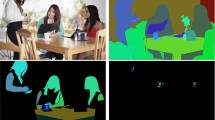Abstract
Semantic image segmentation in computer networks is designed to determine the category to which each pixel in an image belongs. It is a basic computer vision task and has a very wide range of applications in practice. In recent years, semantic image segmentation algorithms in computer networks based on deep learning have attracted widespread attention due to their fast speed and high accuracy. However, due to the large number of downsampling layers in a deep learning model, the segmentation results are usually poor at the edge of an object, and there is currently no universal quantitative evaluation index to measure the performance of segmentation at the edge of an object. Solving these two problems is of great significance to semantic image segmentation algorithms in China. Based on traditional evaluation indicators, this paper proposes a region-based evaluation index to quantitatively measure the performance of segmentation at the edge of an object and proposes an improved loss function to improve model performance. The existing semantic image segmentation methods are summarized. This paper proposes regional-based evaluation indicators. Taking advantage of the particularity of semantic image segmentation tasks, this paper presents an efficient and accurate method for extracting the edges of objects. By defining the distance from pixels to the edges of objects, this paper proposes a fast algorithm for calculating the edge area. Based on this, three methods are proposed as well as an area-based evaluation indicator. The experimental results show that the accuracy of the loss function proposed in this paper, compared with that of the current mainstream cross-entropy loss function, is improved by 1% on the DeepLab model. For area-based evaluation indicators, a 4% accuracy improvement can be achieved, and on other segmentation models, there is also a significant improvement.






Similar content being viewed by others
References
Li, L., Qian, Bo, Lian, J.: Traffic scene segmentation based on RGB-D image and deep learning[J]. IEEE Trans Intell Transp Syst 99, 1–6 (2017)
Yi, F., Li, R., Chang, B.: Remote sensing identification method for paddy field in hilly region based on object-oriented analysis[J]. Soc Agri Eng 31(11), 186–193 (2015)
Zhou, X., Takayama, R., Wang, S.: Deep learning of the sectional appearances of 3D CT images for anatomical structure segmentation based on an FCN voting method[J]. Med Phys 44(10), 5221 (2017)
Chen, L.-C., Papandreou, G., Kokkinos, I.: DeepLab: semantic image segmentation with deep convolutional nets, atrous convolution, and fully connected CRFs[J]. IEEE Trans Patt Anal Mach Intell 40(4), 834–848 (2016)
Yanming Guo, Yu, Liu, A.O.: Deep learning for visual understanding: a review[J]. Neurocomputing 187, 27–48 (2015)
Shi, J.-F., Liu, F., Lin, Y.-H.: Polarimetric SAR image classification based on deep learning and hierarchical semantic model[J]. Acta Automatica Sinica 43(2), 215–226 (2017)
Harley, A.W., Derpanis, K., Iasonas, K.: Learning dense convolutional embeddings for semantic segmentation[J]. Computer Sci 79(10), 1337–1342 (2015)
Li, M.-X., Su-Qin, Yu, Zhang, W.: Segmentation of retinal fluid based on deep learning: application of three-dimensional fully convolutional neural networks in optical coherence tomography images[J]. Internat J Ophthalmol 12(6), 1012–1020 (2019)
Lee, M.-J., Choi, S.-Y., Jeong, H.-J.: A precise image crawling system with image classification based on deep learning[J]. Adv Sci Lett 23(3), 1623–1626 (2017)
Tian, J.-X., Liu, G.-C., Gu, S.-S.: Deep learning in medical image analysis and its challenges[J]. Zidonghua Xuebao/acta Automatica Sinica 44(3), 401–424 (2018)
Wang, B., Xiong, H., Lin, W.: Multitask learning of compact semantic codebooks for context-aware scene modeling[J]. IEEE Trans Image Process 25(11), 5411–5426 (2016)
Kristan, M., Sulic, V., Kovacic, S.: Fast image-based obstacle detection from unmanned surface vehicles[J]. IEEE Trans Cybern 46(3), 641–654 (2015)
Qin, Z., Shelton, C.R.: Event detection in continuous video: an inference in point process approach[J]. IEEE Trans Image Process 26(12), 5680–5691 (2017)
Zhang, F., Zhong, B.-J.: Image retrieval based on interested objects[J]. Tien Tzu Hsueh Pao/Acta Electronica Sinica 46(8), 1915–1923 (2018)
Tsai, Y.-H., Shen, X., Lin, Z.: Sky is not the limit: semantic-aware sky replacement[J]. Acm Trans Graph 35(4), 1–11 (2016)
Thirunarayanan, I., Khetarpal, K., Koppal, S.: Creating segments and effects on comics by clustering gaze data[J]. Acm Trans Multimed Comput Commun Appl 13(3), 1–23 (2017)
Ye, F., Li, W., Chen, J.: Image fast segmentation algorithm based on saliency region detection and level set[J]. Dianzi Yu Xinxi Xuebao/J Elect Infor Technol 39(11), 2661–2668 (2017)
LIU, L.-M., LI, K.-Q., LIAO, X.-L.: Heat co-diffusion based image co-segmentation algorithm[J]. J Optoelect·Laser 27(10), 1111–1119 (2016)
Wu, Q.-H., Wu, J., Zhu, L.: Image segmentation algorithm based on graph theory and FCM[J]. Chin J Liquid Cryst Displ 31(1), 112–116 (2016)
Wu, Q.-H., Wu, J., Zhu, L.: Image segmentation algorithm based on graph theory and FCM[J]. Chin J Liqu Cryst Disp 31(1), 112–116 (2016)
Wang, X.-H., Wang, J.-L., Fang, L.-L.: An adaptive C-V image segmentation model guided by gray difference energy function[J]. Patt Recognit Art Intell 28(3), 214–222 (2015)
Xu, L., Lü, J.: Bayberry image segmentation based on homomorphic filtering and K-means clustering algorithm[J]. Chin Soc Agricult Eng 31(14), 202–208 (2015)
Anupama, N., Kumar, S.S., Reddy, S.E.: Generalized rough intuitionistic fuzzy c-means for MR brain image segmentation[J]. Iet Image Process 11(9), 777–785 (2017)
Wang Chunyan, Xu, Aigong, Y.B.: High resolution remote sensing image segmentation based on the interval type-2 fuzzy model[J]. Chin J Sci Inst 37(3), 658–666 (2016)
Huang, C., Zeng, Li: Level set evolution model for image segmentation based on variable exponent p-Laplace equation[J]. Appl Math Model 40(17–18), 7739–7750 (2016)
Acknowledgements
This work was supported by the grants from Hubei Provincial Collaborative Innovation Centre of Agricultural E-Commerce [Wuhan Donghu University Research (2019) No.17 Document].
Author information
Authors and Affiliations
Corresponding author
Additional information
Publisher's Note
Springer Nature remains neutral with regard to jurisdictional claims in published maps and institutional affiliations.
Rights and permissions
About this article
Cite this article
He, D., Xie, C. Semantic image segmentation algorithm in a deep learning computer network. Multimedia Systems 28, 2065–2077 (2022). https://doi.org/10.1007/s00530-020-00678-1
Published:
Issue Date:
DOI: https://doi.org/10.1007/s00530-020-00678-1




